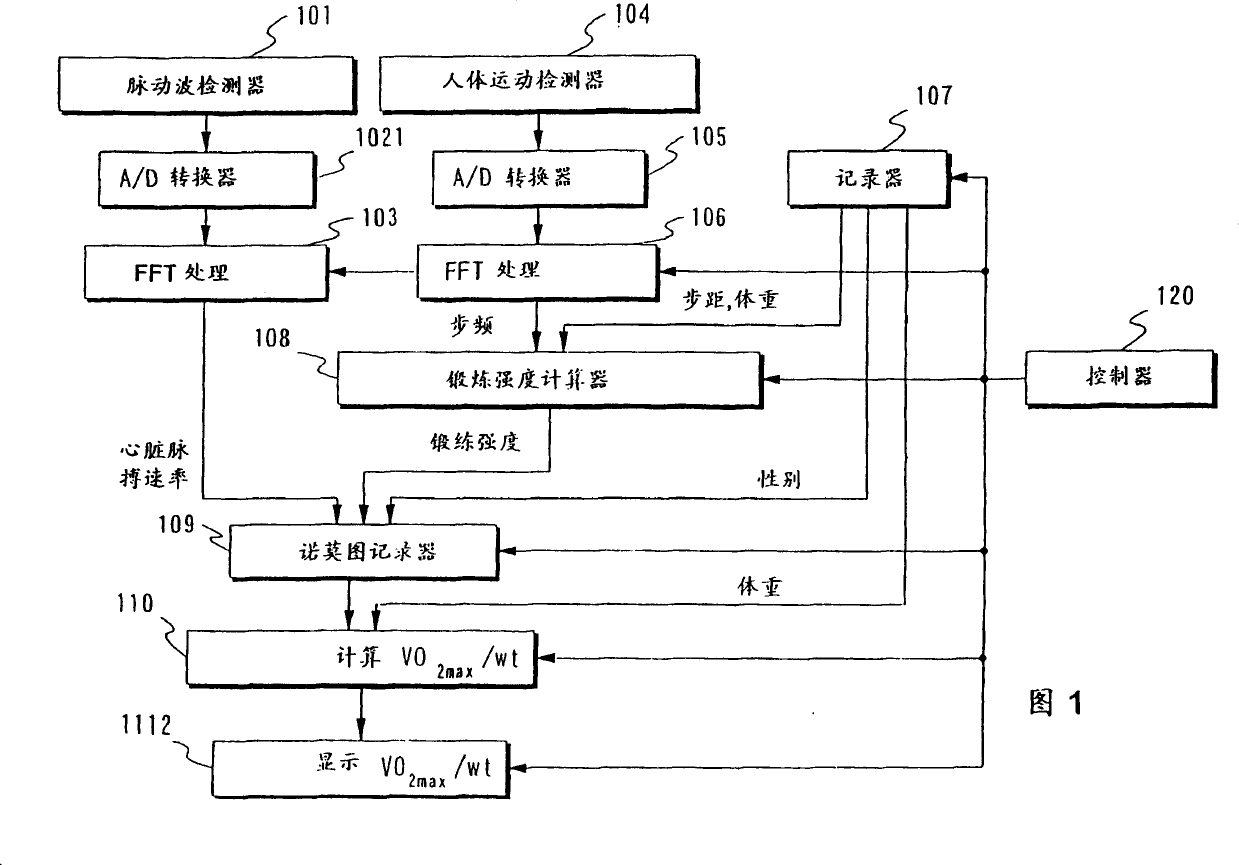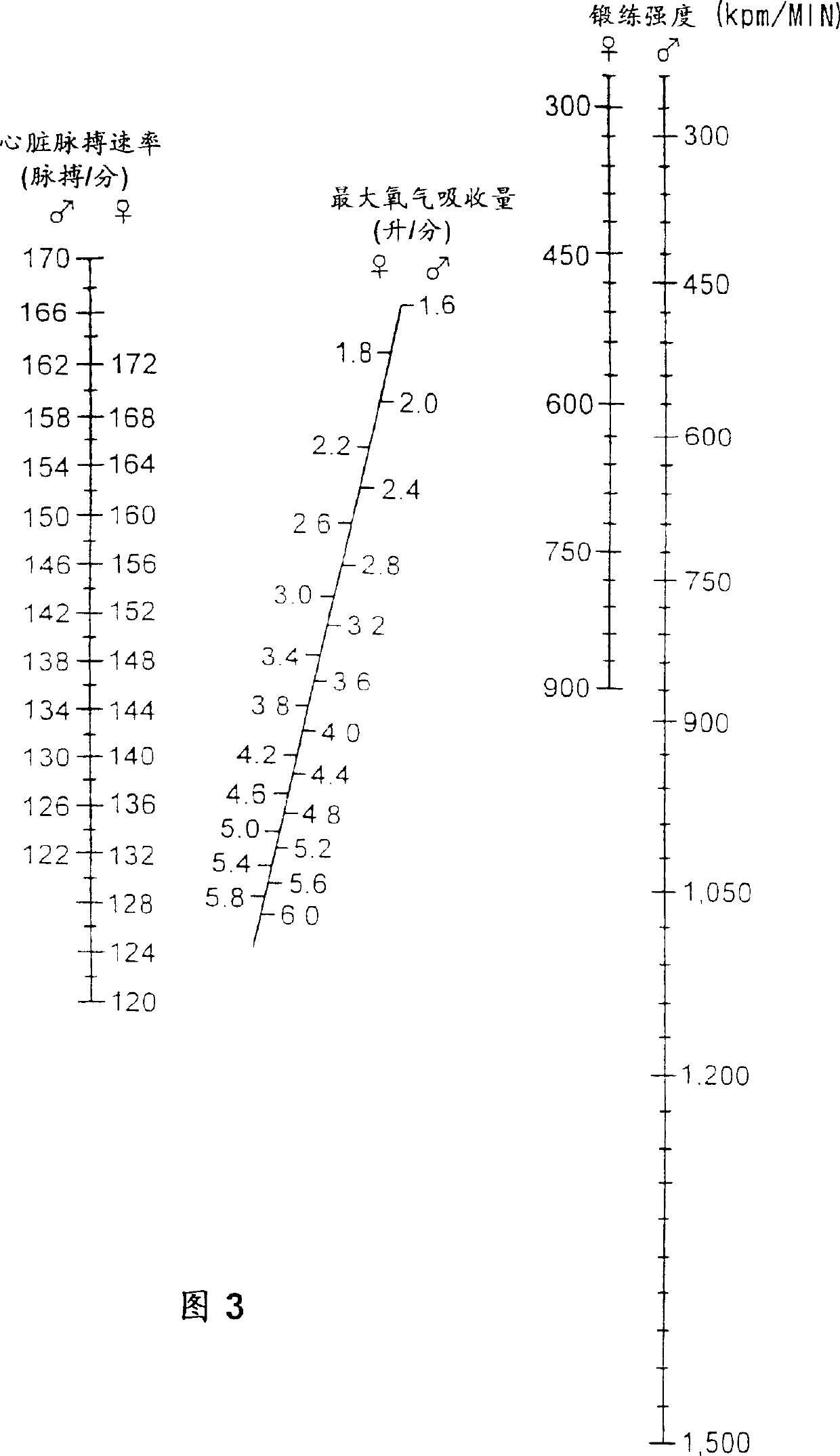Motion prescription support device
A technology of auxiliary devices and recording devices, applied in applications, metrology, measuring pulse rate/heart rate, etc., can solve problems such as user troubles
- Summary
- Abstract
- Description
- Claims
- Application Information
AI Technical Summary
Problems solved by technology
Method used
Image
Examples
Embodiment 1
[0088] A first preferred embodiment of the present invention will be described below with reference to the accompanying drawings.
[0089] 1.1 Structure of the embodiment
[0090] First, the maximum oxygen absorption amount estimating means of the first embodiment will be explained. According to the maximum oxygen uptake estimating device described in this embodiment, in order to estimate the maximum oxygen uptake (VO 2max (liter / min)) instead of the Astrand-Ryhming nomogram (Astrand, P.O and Ryhming, I.: Nomogram for the calculation of oxygen demand (physical strength appropriate) from the pulse rate during submaximal activity.
[0091] J. Appl. Physiol., 218-221, 1954). This estimate is then divided by the test subject's body weight to obtain the maximum oxygen uptake per unit body weight (VO 2max / wt (unit: milliliter / kg / min)).
[0092] 1.1.1.Astrond-Ryhming nomogram
[0093] Before explaining this embodiment, a brief description will be given to the aforementioned Ast...
Embodiment 2
[0194] Next, a second embodiment of the present invention will be explained.
[0195] Although there are small differences between individuals, it is generally believed that when the cadence of running is increased, the stride length is shortened. However, in the first embodiment, since the step value set in the RAM 203 is used without modification, the step value used is constant despite the fact that the step frequency is increased. That is to say, the first embodiment does not consider this characteristic during running.
[0196] Therefore, from this point of view, the first embodiment has a defect that the exercise intensity obtained in step Sa3 is inaccurate.
[0197] Therefore, in the second embodiment, a graph showing the relationship between the pitch frequency and the pitch correction coefficient is prepared and stored in advance. When the stride frequency changes during running, the stride correction coefficient corresponding to the changed stride frequency is read...
Embodiment 3
[0205] A third embodiment of the present invention will now be explained.
[0206] When running, you don't need to limit your range of motion to flat roads. Instead it can be on normal roads which usually have some slopes. When running with an incline, the stride length will be shorter when running uphill and longer when running downhill (however, when running a marathon In people, this relationship is reversed).
[0207] Therefore, when running on an incline, the stride length will change even though the stride frequency remains the same. Therefore, the intensity of exercise changes. However, in the first embodiment described above, the step value set in the RAM 203 is used. Also, if the cadence is constant, the intensity of the workout is calculated based on the constant cadence value even if there is a slope.
[0208] So the disadvantage of the first embodiment is that the exercise intensity obtained in step Sa3 is not accurate.
[0209] Therefore, in the third embodi...
PUM
 Login to View More
Login to View More Abstract
Description
Claims
Application Information
 Login to View More
Login to View More - Generate Ideas
- Intellectual Property
- Life Sciences
- Materials
- Tech Scout
- Unparalleled Data Quality
- Higher Quality Content
- 60% Fewer Hallucinations
Browse by: Latest US Patents, China's latest patents, Technical Efficacy Thesaurus, Application Domain, Technology Topic, Popular Technical Reports.
© 2025 PatSnap. All rights reserved.Legal|Privacy policy|Modern Slavery Act Transparency Statement|Sitemap|About US| Contact US: help@patsnap.com



